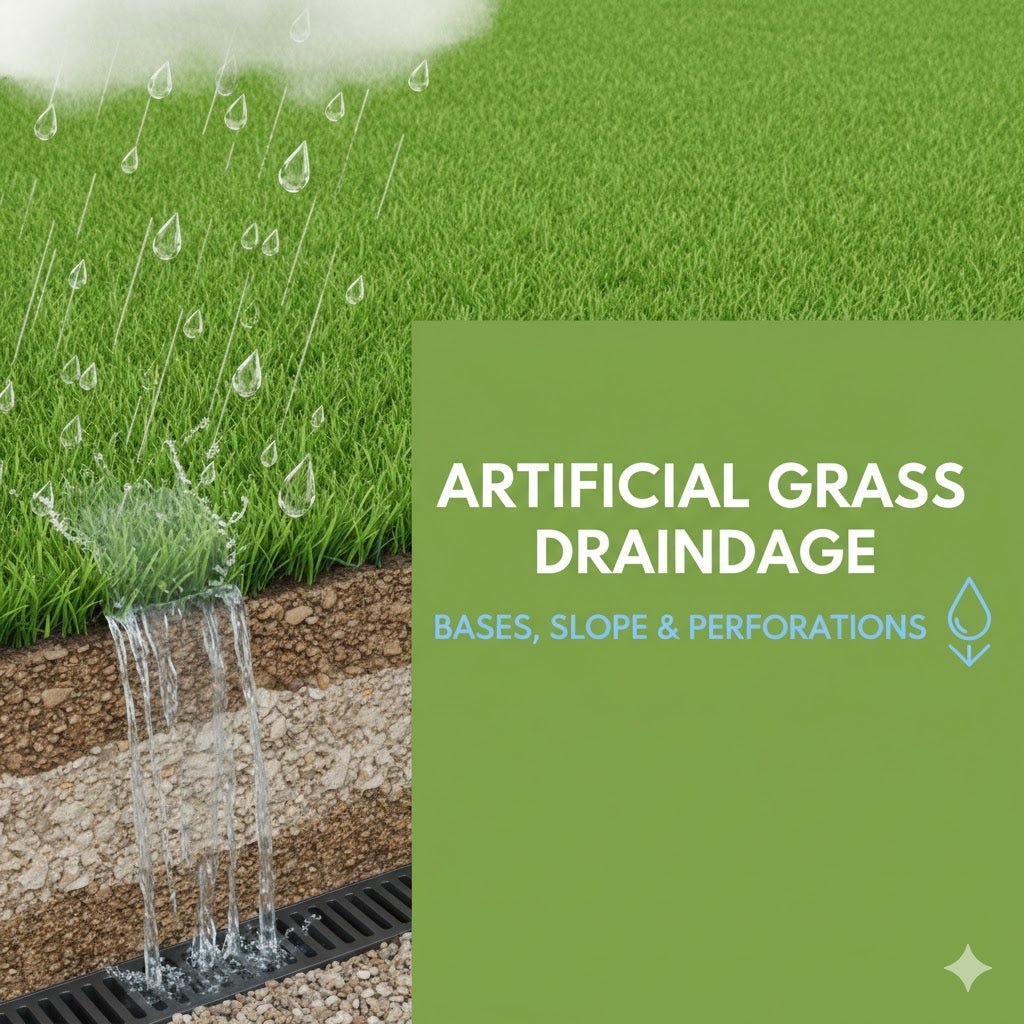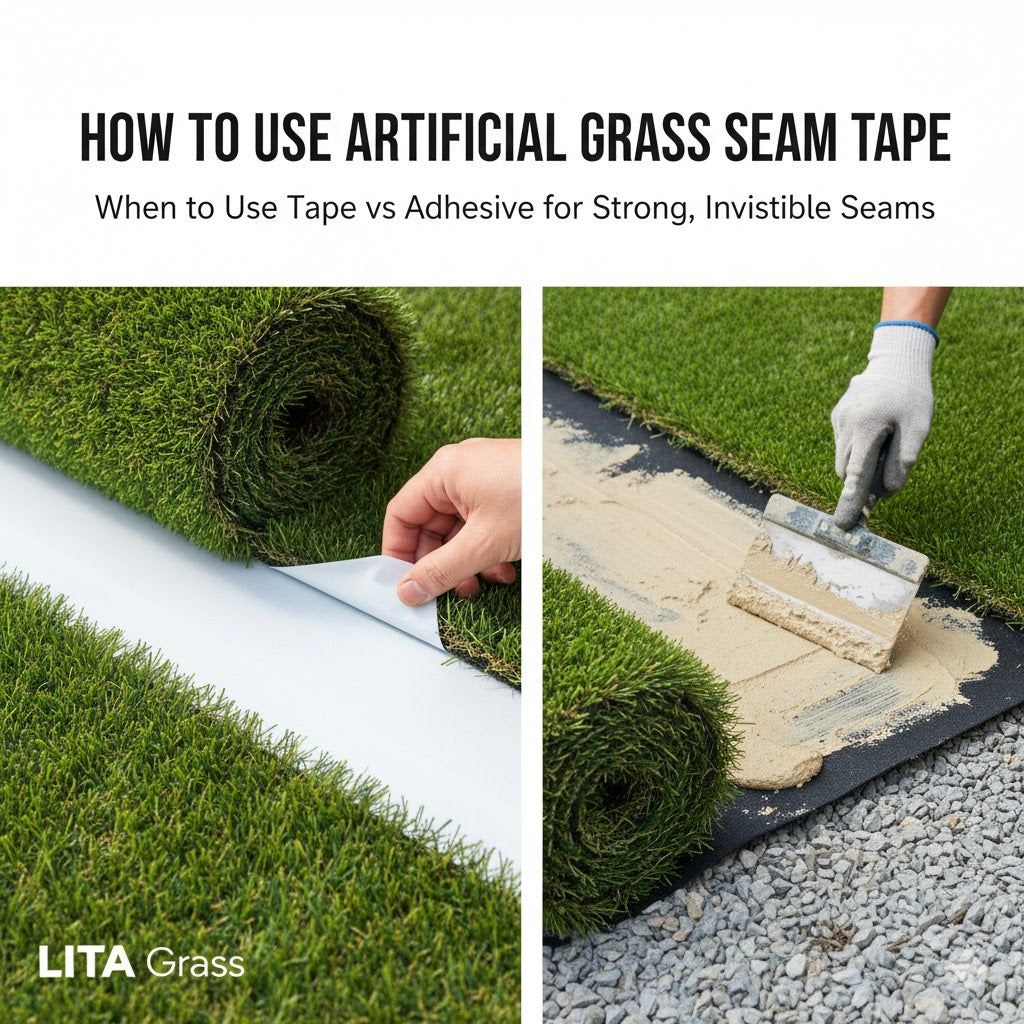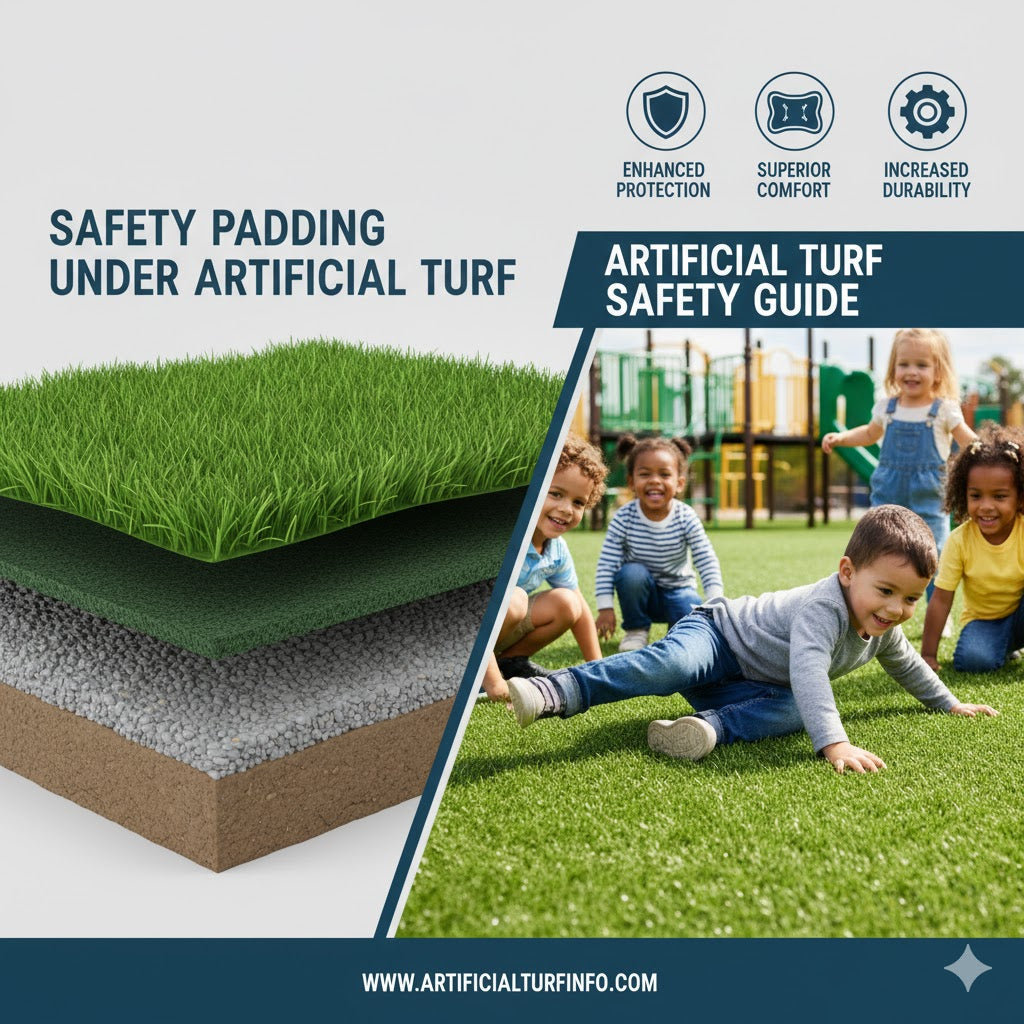Drainage is the most important part of an artificial grass installation. If water can’t move through and away from the turf, problems show up fast. Puddles form, grass smells bad, and the surface wears out early.
The good news is that modern turf is built to handle rain, pets, and play. With the right base, slope, and turf backing, your lawn stays dry and safe. In this guide, we’ll break down how artificial grass drainage works and how you can avoid common mistakes.
What Artificial Grass Drainage Means?
Artificial grass drainage is how water moves through turf and out of your yard. The turf has a backing with holes or a fully open design. Water passes through the holes, then into a base of stone or gravel. From there, the water runs off with the slope of your yard.
If the ground below is prepared the right way, rainwater will not sit on the surface. Instead, it drains fast, even after heavy rains. Good drainage keeps your lawn safe to walk on and makes it last longer.
How Synthetic Turf Moves Water (Backings & Drainage Holes)
Artificial turf does not soak up water like real soil. Instead, it lets water pass through its backing. The way this happens depends on the type of turf.
Hole-Punched (the Common Type)
Most turf has a backing with small drainage holes spread out every few inches. Rainwater or hose water falls through the holes, then flows into the base below. This design works well for many homes and play areas.
Fully Permeable (Edge-to-Edge)
Some turf is fully open, so water drains anywhere on the surface. This option is better for pet areas or places with a lot of water. It helps avoid puddles and keeps smells from building up.
Choosing the Right Infill
Infill adds extra weight to hold the turf in place and helps the blades stand up. But the wrong infill can block the holes. Always choose infill that allows water to pass through without slowing drainage. LITA Grass offers both standard perforated turf and fully permeable options, giving homeowners flexibility based on yard size and rainfall.

Build the Sub-Base Layer for Reliable Flow
The base under artificial grass is what makes drainage work. Without a good base, water will sit on top of the turf.
Materials That Drain
The best base is made of crushed stone, gravel, or decomposed granite. These materials let water pass through quickly. Avoid fine dirt or sand that can pack down tight and block water. In some areas, people use inches of shale, but always check if it works with your soil.
Depth and Layers
Most yards need about 3–4 inches of compacted base. Spread the base in thin layers and pack each one down before adding the next. In wet or clay soils, you may need a thicker base or a fabric layer to keep soil from mixing with stone.
Test the Base
Before laying turf, test drainage with a garden hose. If water runs through and spreads evenly, the base is ready. If puddles form, fix them by flattening or adding more clean stone.
Get the Slope Right: Small Numbers, Big Difference
Water needs a path to leave your yard. That path comes from slope. Even a small slope makes a big difference.
Target Gradients
Aim for a slope of 1–2%. That means the ground drops about 1–2 inches for every 8–10 feet. You won’t notice it when looking at your lawn, but water will.
When the Yard Sits Low
If your lawn sits lower than the area around it, water will collect. In that case, you may need a French drain or a dry well. These give water a way out. The drain pipe should have a gentle fall so it never clogs.
Hardscape Installs
When turf goes over concrete, balconies, or rooftops, slope is even more important. Add drainage panels under the turf so water can flow sideways toward a drain or edge.
Correct grading supercharges artificial grass drainage during heavy rains.
Perforations, Hole Spacing & Backing Choices
The turf backing decides how water escapes. Picking the right one avoids drainage problems.
What Spacing Does
Turf with hole-punch backings has small holes every few inches. Closer spacing helps water flow better during heavy rains. Keep these holes clear when installing. Don’t block them with glue or fine debris.
Backing Materials
Most turf backings are made with latex or polyurethane. Some are fully permeable, which means water can exit anywhere on the surface. These are useful in wet climates or pet yards where fast drainage matters.
Pets and Odor
Pet urine can cause bad smells if it gets trapped. Fully permeable turf with antimicrobial or zeolite infills helps. It drains faster, reduces odor, and is easier to clean with a hose.

Artificial Grass vs Natural Grass: Which Drains Better?
Natural grass depends on soil to drain water. If the soil is clay or compacted, water pools and lawns turn muddy. Artificial turf avoids that when it is installed the right way.
It Depends on Ground Preparation
Artificial turf can drain better than natural grass if the base is built correctly. A 3–4 inch sub-base layer of stone gives water a clear path out. On unprepared ground, though, turf can have the same poor drainage problems as real grass.
Maintenance Requirements
Artificial turf dries fast and avoids mud. This means fewer days lost after storms and less cleanup. You don’t deal with soggy soil or the constant mess. These low-maintenance benefits are a main reason people switch.
Diagnosing Bad Drainage — Symptoms, Causes & Fixes
Drainage problems show up quickly in artificial turf. Knowing the signs helps you fix issues before they get worse.
Symptoms
- Puddles sit on the turf after rain.
- The surface smells bad or takes too long to dry.
- Slippery spots make the lawn unsafe.
- Turf fibers flatten or weeds appear through seams.
Root Causes
- Base is flat or uneven.
- Base was compacted too much or not enough.
- Wrong infill blocks drainage holes.
- Original installation skipped slope or hose testing.
- Clay soil or high water table under the yard.
- Lawn sits lower than the rest of the land.
Fix Strategy
- Re-grade the surface to a 1–2% slope.
- Rebuild the sub-base layer with clean stone. Add fabric over clay soils.
- Install a French drain or dry well if water has no exit.
-
Upgrade backing or infill in pet areas to handle liquids better.
Cost and Risk
Fix drainage early. If water damage builds, you may need to rip up turf and rebuild the base. That raises cost of ownership.
Most artificial grass drainage failures start with the base and slope, not the blades.
Installation Paths — DIY vs a Professional Installation Company
You can install artificial grass yourself, but drainage makes it tricky. A small mistake in slope or base can cause big problems later.
When to DIY
DIY works for small, simple spaces like a small patio strip or dog run. You need tools for cutting, compacting, and checking slope. You also need a solid understanding of drainage.
Why Hire Pros
A professional installation company uses grading tools, compactors, and drainage tests. They can handle slopes, odd shapes, and tough soils. A pro team also gives you a warranty. That means if drainage fails, you are covered.
An experienced team will check drainage efficiency before finishing the job. Companies like DFW Turf Solutions and other local installers offer different installation options, including systems for pets.
Specs You Can Copy — Bases, Slope & Perforations
Here are quick specs you can follow for solid drainage. Specs like these match what LITA Grass recommends in its installation guide.
Turf
Choose perforated or fully permeable turf. Make sure drainage holes stay open during installation. Pick an infill that adds weight but does not clog holes.
Base
Build a 3–4 inch sub-base layer with crushed stone or gravel. Use a geotextile fabric if you have clay soil. On concrete or rooftops, add drainage panels under the turf.
Slope
Grade the finished surface at 1–2% away from buildings or patios. Always give water a safe place to flow, like a drain or dry well.

Health, Safety & Longevity Upsides
Good drainage makes turf safer and helps it last longer.
Usability and Safety
With solid drainage, water runs off instead of pooling. That means fewer slips, less mold, and no standing water for mosquitoes. You can use your lawn soon after heavy rains.
Lifespan and Economics
Drainage protects turf fibers from damage. This keeps the lawn looking good for many years. It also protects the low-maintenance benefits you expect when you invest in artificial turf. Without drainage, the turf wears out early and costs more in repairs.
FAQs on Artificial Grass Drainage
Does all turf allow water to pass?
Most high-quality grass does. The turf backing has holes or a fully open design. But cheap turf or poor installation can block drainage.
Do I need a separate drainage system?
Not always. If your soil drains well, the turf base is enough. For clay soils or low yards, you may need a French drain or dry well.
Can dogs pee on it?
Yes. Fully permeable turf with the right infill is best. Zeolite or antimicrobial infill helps control odor. Rinse with a hose to keep it fresh.
What if my yard has clay?
Clay-based soil slows water. Use a thicker stone base and a fabric layer to separate clay from the base. In tough spots, add subsurface drains.
Conclusion & Next Steps
Artificial grass drainage depends on three things: the base, the slope, and the turf backing. When each part is done right, your lawn drains fast and lasts long.
Build a 3–4 inch stone base, grade it to a 1–2% slope, and pick turf with the right perforations. Add infill that supports drainage, not blocks it.
Before you install, check your soil and plan for water flow. Compare installation options and ask for a drainage test. A little prep now saves big costs later.
Ready to Upgrade Your Lawn?
Don’t risk drainage problems with the wrong turf. Choose a product designed to handle rain, pets, and daily use. LITA Grass offers high-quality artificial turf, accessories, and even installation services in Los Angeles. They also ship nationwide for DIY projects.
Contact LITA Grass today and get a lawn that drains right, looks great, and lasts for years.



Leave a comment
This site is protected by hCaptcha and the hCaptcha Privacy Policy and Terms of Service apply.